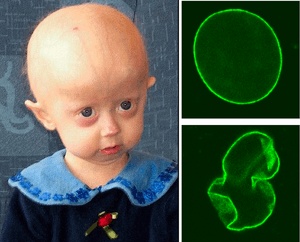Progeroid syndromes facts for kids
Progeroid syndromes (say: pro-JER-oid) are a group of genetic conditions. People with these syndromes seem to grow older much faster than usual. These conditions are caused by a change, called a mutation, in just one gene.
Most often, these gene changes affect how our cells fix their DNA. Or, they can affect a special protein called lamin A/C. This protein helps keep the shape of a cell's control center, called the nucleus.
The word "progeroid" means "looking like old age." Many diseases can make someone look older. But progeroid syndromes are special. They affect many different parts of the body, not just one. For example, Alzheimer's disease affects only the brain.
People with progeroid syndromes often have a shorter life. The most well-known types are Werner syndrome and Hutchinson-Gilford Progeria Syndrome (HGPS). Scientists study these conditions a lot. They want to understand how our bodies age naturally.
Contents
What Are Progeroid Syndromes?
Progeroid syndromes are rare genetic disorders. They make a person show signs of aging very early. These signs can include wrinkled skin or hair loss. They might also have problems with their bones or heart.
Each syndrome is caused by a change in a single gene. This means it's a "monogenetic" condition. It's different from regular aging, which happens over many years.
Common Types of Progeroid Syndromes
Two of the most studied progeroid syndromes are:
Hutchinson-Gilford Progeria Syndrome (HGPS)
HGPS is often just called Progeria. It is a very rare and severe condition. Children with HGPS start showing signs of aging in their first few years of life. They might have slow growth and hair loss. Their skin can become thin and wrinkled.
HGPS is caused by a mutation in the LMNA gene. This gene makes the lamin A protein. Lamin A is important for keeping the cell nucleus strong. When lamin A doesn't work right, the nucleus becomes weak. This can damage cells and make them age faster.
Werner Syndrome (WS)
Werner syndrome is another type of progeroid syndrome. People with WS usually start showing signs of aging in their teenage years or early twenties. They might get gray hair early. Their skin can become tough. They may also develop health problems common in older adults. These include cataracts (cloudy eyes) and diabetes.
Werner syndrome is caused by a mutation in the WRN gene. This gene helps repair DNA. When the WRN gene is faulty, DNA repair doesn't work well. This can lead to cell damage and faster aging.
Why Do Scientists Study Progeroid Syndromes?
Scientists are very interested in progeroid syndromes. These conditions show how fast aging can happen. By studying them, researchers hope to learn more about the natural aging process. This research can help us understand:
- How cells age and die.
- How our bodies repair themselves.
- How stem cells work.
- What causes diseases like cancer.
Understanding these syndromes could lead to new ways to treat age-related diseases. It might even help us live healthier, longer lives.
Images for kids



